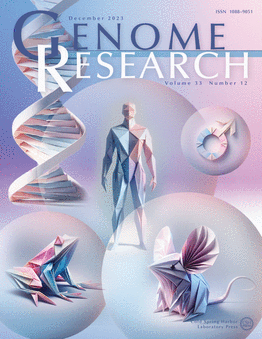Characterization of the role of spatial proximity of DNA double-strand breaks in the formation of CRISPR-Cas9-induced large structural variations
IF 6.2
2区 生物学
Q1 BIOCHEMISTRY & MOLECULAR BIOLOGY
引用次数: 0
Abstract
Structural variations (SVs) play important roles in genetic diversity, evolution, and carcinogenesis and are, as such, important for human health. However, it remains unclear how spatial proximity of double-strand breaks (DSBs) affects the formation of SVs. To investigate if spatial proximity between two DSBs affects DNA repair, we used data from 3C experiments (Hi-C, ChIA-PET, and ChIP-seq) to identify highly interacting loci on six different chromosomes. The target regions correlate with the borders of mega-base sized Topologically Associated Domains (TADs), and we used CRISPR-Cas9 nuclease and pairs of single guide RNAs (sgRNAs) against these targets to generate DSBs in both K562 cells and H9 human embryonic stem cells (hESC). Droplet Digital PCR (ddPCR) was used to quantify the resulting recombination events, and high-throughput sequencing was used to analyze the chimeric junctions created between the two DSBs. We observe a significantly higher formation frequency of deletions and inversions with DSBs in proximity as compared to deletions and inversions with DSBs not in proximity in K562 cells. Additionally, our results suggest that DSB proximity may affect the ligation of chimeric deletion junctions. Taken together, spatial proximity between DSBs is a significant predictor of large-scale deletion and inversion frequency induced by CRISPR-Cas9 in K562 cells. This finding has implications for understanding SVs in the human genome and for the future application of CRISPR-Cas9 in gene editing and the modelling of rare SVs.DNA双链断裂的空间邻近性在crispr - cas9诱导的大结构变异形成中的作用
结构变异(SVs)在遗传多样性、进化和致癌作用中发挥着重要作用,因此对人类健康非常重要。然而,双链断裂(dsb)的空间邻近性如何影响sv的形成尚不清楚。为了研究两个dsb之间的空间接近是否会影响DNA修复,我们使用了3C实验(Hi-C, china - pet和ChIP-seq)的数据来鉴定六条不同染色体上高度相互作用的位点。靶区与大碱基大小的拓扑相关结构域(TADs)的边界相关,我们使用CRISPR-Cas9核酸酶和针对这些靶点的单向导rna对(sgRNAs)在K562细胞和H9人胚胎干细胞(hESC)中生成dsb。利用液滴数字PCR (ddPCR)对重组事件进行定量分析,并利用高通量测序对两个dsb之间的嵌合连接进行分析。我们观察到在K562细胞中,与dsb邻近的缺失和反转相比,dsb邻近的缺失和反转的形成频率明显更高。此外,我们的结果表明,DSB邻近可能影响嵌合缺失连接的连接。综上所述,dsb之间的空间接近性是CRISPR-Cas9在K562细胞中诱导的大规模缺失和反转频率的重要预测因子。这一发现对理解人类基因组中的SVs以及CRISPR-Cas9在基因编辑和罕见SVs建模中的未来应用具有重要意义。
本文章由计算机程序翻译,如有差异,请以英文原文为准。
求助全文
约1分钟内获得全文
求助全文
来源期刊

Genome research
生物-生化与分子生物学
CiteScore
12.40
自引率
1.40%
发文量
140
审稿时长
6 months
期刊介绍:
Launched in 1995, Genome Research is an international, continuously published, peer-reviewed journal that focuses on research that provides novel insights into the genome biology of all organisms, including advances in genomic medicine.
Among the topics considered by the journal are genome structure and function, comparative genomics, molecular evolution, genome-scale quantitative and population genetics, proteomics, epigenomics, and systems biology. The journal also features exciting gene discoveries and reports of cutting-edge computational biology and high-throughput methodologies.
New data in these areas are published as research papers, or methods and resource reports that provide novel information on technologies or tools that will be of interest to a broad readership. Complete data sets are presented electronically on the journal''s web site where appropriate. The journal also provides Reviews, Perspectives, and Insight/Outlook articles, which present commentary on the latest advances published both here and elsewhere, placing such progress in its broader biological context.
 求助内容:
求助内容: 应助结果提醒方式:
应助结果提醒方式:


